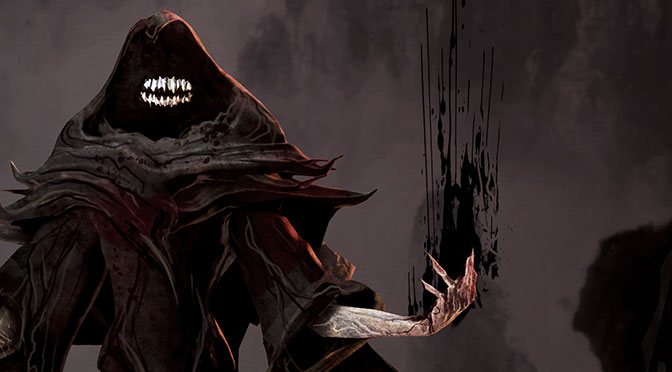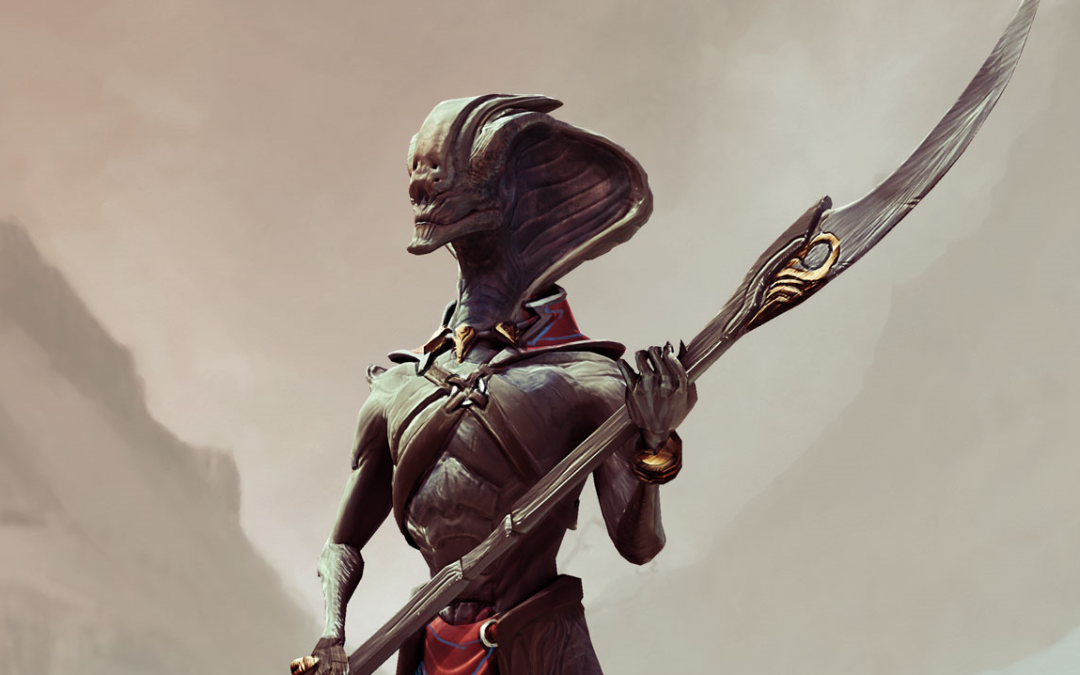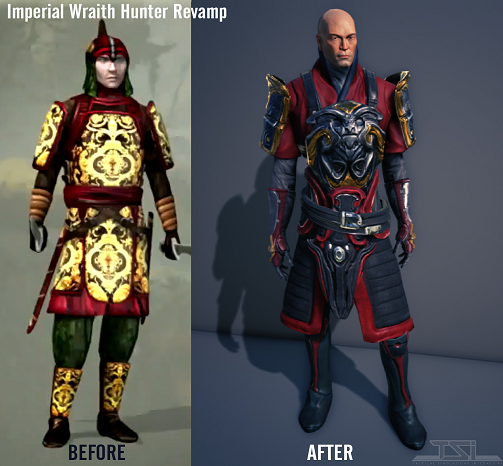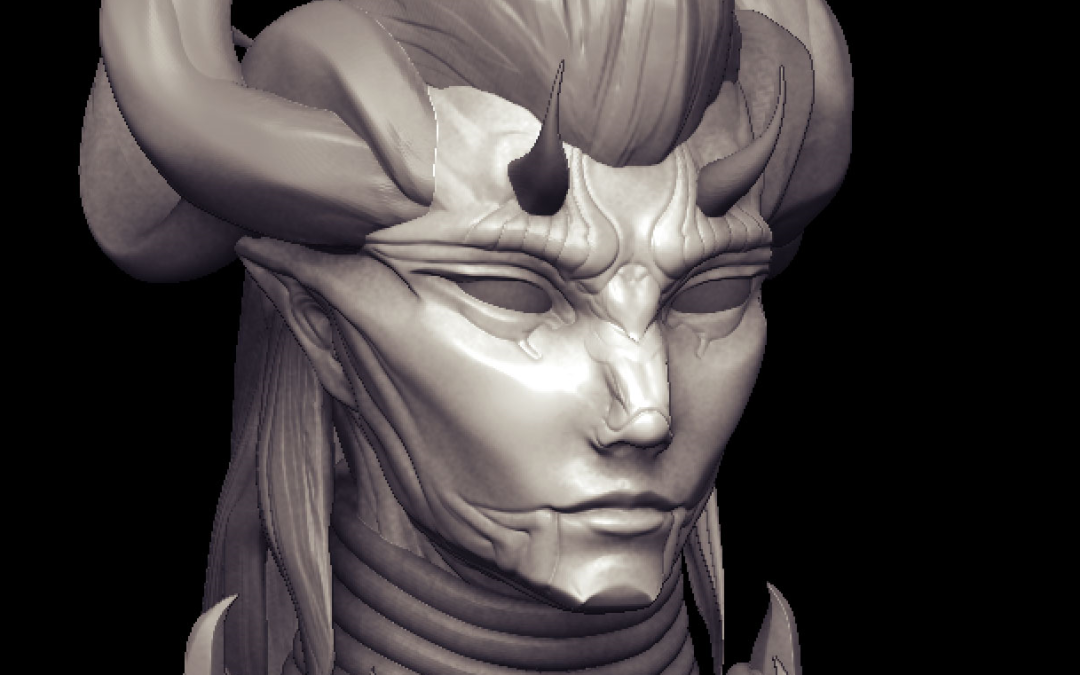
by Design1 | Aug 18, 2015 | Uncategorized
A servant of the dark, hungry for life’s energy. One of the many less savoury beings which inhabit the shadowy corners of the world in Seven Dragon Saga. We continue heads down through summer, though it does look pretty seeing the blue sky out through the windows. We are pushing forward until we have sufficient material for the game to really feel like something of quality and polish. The design team completed a draft on the various types of crafting, and Paul is taking a new pass at looting, merchants, quest rewards and the economy in general, in light of ingredients and recipes. The goal is to get the characters not too rich and not too poor, as well as distributing items throughout all the regions. On the story side, David and Edwin have broken the world down into seven regions, each with an average of four major points of interest. From this, we can fill out the details on factions and important NPCs, and how the whole game should play out. Starting to tally up asset requirements, and working with the art team to confirm it will all fit within their budget. Sebastian has completed the basics for combat and movement in the prototype, and is now laying the groundwork to import the new player character models, and their whole range of animations. As that wraps up, we expect Amanda of the art team to start delivering full quality environmental assets. And the animation team should also be set to deliver the first batch of fully rigged and animated enemies, such as the Slyth we showed last update....

by Design1 | Jul 23, 2015 | Uncategorized
Meet the Slyth Warden, one of the many dragonkin who vie for dominance in the mountains of the Firewind Coast. Suspicious of the empire, they are likely enemies, but with the right inducements, they could be powerful allies. It’s all a matter of player choice, as they adventure deep into the Drakelands, in service to their emperor. We are proceeding along developing different elements of the game. In Engineering, we’ve been running various elements of combat and movement through prototyping. Checking out how best to implement multiple targets, area of effect attacks, and persistent things like zones. On the movement side, Seven Dragon Saga has a number of methods to move, and we want them to feel different and work clearly. Mystic Leap allows characters to leap up onto areas others can’t, and gain height advantage. Special thanks to junior engineer Sebastian for taking point on the prototype process. Up next is how best for the game to recognize cover, then determine if it is half or full, and convey this in an intelligent manner to the players. Then there are Attacks of Opportunity and the Retaliate ability to work out. Lots of little details where frequent prototype iterations works wonders. In design, we are creating flow charts for story progression, depending on which factions the player is aiding, and which he’s harming. David Shelley pushes a strategic vision, while Edwin McRae drives things from an NPC and story arc viewpoint. This all feeds into the locations we need, and hence the environmental art required. In systems, Paul Murray and David Shelley are...

by Design1 | Jun 4, 2015 | Game Development, TSI
Hi there – So things have been pretty quiet here news wise and that’s largely my fault. I joined up with the TSI about a month and a half ago to take over the art direction on Seven Dragon Saga. Since then I’ve read several hundred pages of community comments on the previous iteration of the games visuals along with digesting the exhaustive documentation for the games world and gameplay mechanics so I can feed all of that into our new look which is what we’re ready to talk more about today. But before we get into that I should give a little background on myself. I’m Lee Dotson, I’ve been making art for games for about 18 years now covering almost every genre of game out there including games like Anachronox, Star Trek Online, and Diablo 3 but classic RPG’s are what make me want to create games in the first place so 7DS’s open ended storylines and rich X-Com like tactical gameplay makes this a total dream project for me. Enough about me, here we have a small example of where we’ve been and where we’re going with the style and look of 7DS. The goal here is to push for a look that merges the sense of fantastic realism found in classic fantasy paintings by the likes of Brom or Easely with the rich colors and clear designs from classic dungeon crawlers like Eye of the Beholder so there’s a feast for the eyes when zooming in on characters while keeping everything legible from far away. For me this is particularly key because while...

by Design1 | May 7, 2015 | Game Development
The world of Seven Dragon Saga is populated with a wide variety of beings; humans, humanoids, monsters, dragons and many strange creatures that defy categorization. For instance, the Firewind Coast is noted for its dragonkin. Dragonkin is a broad term that covers any living creature that has some proportion of dragon blood flowing in its veins. Dragons are highly inquisitive beings, driven by brilliant intellect and strong passions. They love to use their shapeshifting powers to mingle and breed with the humans, humanoids and beasts of the Firewind Coast. As a result, they have spawned many a unique and often bizarre breed of creature. Two such monstrous dragonkin are the Drakes and the Wyrms. Drakes are airborne whilst Wyrms are earthbound, yet their individual strengths and weaknesses can vary dramatically depending on the concentration of dragon blood in their veins. Early Draft of Drakyri Feydri, Drakyri and the Dragonspurn The Feydri and the Drakyri are humanoid races that are native to the Firewind Coast. Both claim varying degrees of dragon ancestry, although it tends to manifest more prominently in the Feydri. The Drakyri These resilient dragonkin have dwelt underground since a tragic conflict with their dragon ancestors drove them from the surface, many centuries ago. Seldom growing over five feet in height, they tend towards a light and agile build, a physicality best suited to subterranean living. Their skin is pale and their eyes have grown accustomed to dark conditions. The Drakyri live in small, tight-knit clans ruled by a patriarch. They subsist on a combination of fungus farming, and hunting and fishing in chthonian lakes. Their economy...
by Design1 | Mar 20, 2015 | Uncategorized
Where Race give shape to the character, innate toughness, mobility, senses, and link to the mystical; and Class defined the character’s core features; Specialty gives it a final direction. Experimenting with the three pieces is quick and fun, and generates interesting synergies. Here is an overview of the Specialties. Deadly. Extra attacks during the encounter, extra damage, increases to the statistic used for damage, and the Mystic Leap ability to get to where you need to deal damage. Did I say damage often enough? Works well with any character you don’t want focused on support. Tactical. Some damage support, but more importantly, it gives a character access to all the weapons in the game. Prefer your Knight to be sword and board? Make him a Tactical Knight. Want the Scout to be up close and personal with blades? Make him Tactical. Fast. The best Mystic Leaping range of any class, lots of teleports, some extra actions to get extra movement. If you want the character to get where the enemy is weakest, or kite the slow beast, then Fast is a good choice. Shade Elves and Half Shades have an innate Flash Step, which can complement Fast, while the dragonkin races have Surefooted, meaning they ignore difficult terrain. Priestly. This is an overall control and support Specialty. Some healing, anti-magic, harm undead, pin, leadership, a few talismans to toss around, and some good social skills make this an all-around useful choice. Priestly Soultenders get very strong heals, while Priestly Wraith Hunters have the best harm undead. A Priestly Wizard can both cast spells and cancel...





